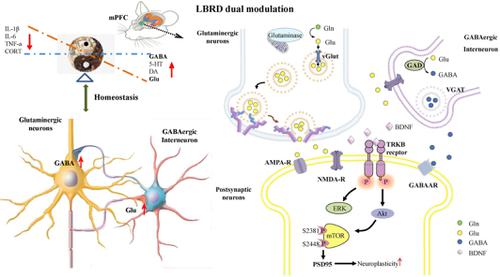当前位置:
X-MOL 学术
›
Genes Brain Behav.
›
论文详情
Our official English website, www.x-mol.net, welcomes your feedback! (Note: you will need to create a separate account there.)
Antidepressant mechanism of classical herbal formula lily bulb and Rehmannia decoction: insights from gene expression profile of medial prefrontal cortex of mice with stress-induced depression-like behavior.
Genes, Brain and Behavior ( IF 2.5 ) Pub Date : 2020-03-04 , DOI: 10.1111/gbb.12649 Hongxiu Zhang 1, 2 , Xiansu Chi 1 , Wenchao Pan 1 , Shijun Wang 1 , Zhe Zhang 1 , Haijun Zhao 1 , Yuan Wang 1 , Zhichun Wu 1 , Miaomiao Zhou 1 , Shan Ma 1 , Qitao Zhao 1 , Ke Ma 1
Genes, Brain and Behavior ( IF 2.5 ) Pub Date : 2020-03-04 , DOI: 10.1111/gbb.12649 Hongxiu Zhang 1, 2 , Xiansu Chi 1 , Wenchao Pan 1 , Shijun Wang 1 , Zhe Zhang 1 , Haijun Zhao 1 , Yuan Wang 1 , Zhichun Wu 1 , Miaomiao Zhou 1 , Shan Ma 1 , Qitao Zhao 1 , Ke Ma 1
Affiliation

|
According to traditional Chinese medicine, lily bulb and Rehmannia decoction (LBRD) is a specialized formula for the treatment of “lily disease”, the symptoms of which resemble the clinical manifestations of major depression. However, the molecular basis of the antidepressant mechanism of LBRD and the quality marker ingredients of LBRD remain unclear. This study aimed to investigate the quality marker ingredients of LBRD and to show the molecular mechanism of its antidepressant activities. In this study, we adopted the chronic unpredicted mild stress paradigm to construct a depression model. High‐performance liquid chromatography (HPLC) was used to determine the levels of the main markers in LBRD. The underlying mechanism of LBRD was explored by measuring neurotransmitter and cytokine levels using enzyme‐linked immunosorbent assay, and by quantifying differentially expressed gene (DEG) of transcriptome in the medial prefrontal cortex (mPFC) tissue through RNA sequencing. HPLC results showed that the average levels of quality marker ingredients of LBRD (ferulic acid, dioscin, verbascoside and catalpol) were 0.00079%, 0.00039%, 0.7% and 1.6% (w/w), respectively. LBRD intervention significantly attenuated the depressive phenotype compared with that in the depressed group. LBRD treatment altered the enriched DEGs in the signaling pathways of γ‐aminobutyric acid (GABA) and glutamate neurotransmitter, synaptic plasticity and axon guidance, circadian rhythm and neural‐immunity. GABAergic and glutamatergic synapses as well as brain‐derived neurotrophic factor (BDNF)/TrkB‐dependent phosphoinositide 3‐kinase (PI3K)/Akt/mammalian target of rapamycin‐1 (mTOR1), might be the main signaling pathways underlying the multi‐target therapeutic effects of LBRD against depression.
中文翻译:

经典草药百合鳞茎和熟地汤的抗抑郁机制:应激诱导的抑郁样行为小鼠内侧前额叶皮层基因表达谱的见解。
根据中医药,百合鳞茎和生地黄汤是治疗“百合病”的专门配方,其症状类似于严重抑郁症的临床表现。然而,尚不清楚LBRD抗抑郁机制的分子基础和LBRD的质量标志成分。这项研究旨在调查LBRD的质量标志成分,并显示其抗抑郁活性的分子机制。在这项研究中,我们采用了慢性不可预测的轻度压力范式来构建抑郁模型。高效液相色谱(HPLC)用于确定LBRD中主要标志物的水平。LBRD的潜在机制是通过使用酶联免疫吸附测定法测量神经递质和细胞因子水平来探索的,并通过RNA测序定量内侧前额叶皮层(mPFC)组织中转录组的差异表达基因(DEG)。HPLC结果表明,LBRD的质量标志物成分(阿魏酸,薯os皂素,马齿bas苷和梓醇)的平均水平分别为0.00079%,0.00039%,0.7%和1.6%(w / w)。与抑郁组相比,LBRD干预显着减轻了抑郁表型。LBRD处理改变了γ-氨基丁酸(GABA)和谷氨酸神经递质,突触可塑性和轴突引导,昼夜节律和神经免疫的信号传导途径中富集的DEG。GABA能和谷氨酸能的突触,以及脑源性神经营养因子(BDNF)/ TrkB依赖性磷酸肌醇3激酶(PI3K)/ Akt /哺乳动物雷帕霉素-1(mTOR1)靶标,
更新日期:2020-03-04
中文翻译:

经典草药百合鳞茎和熟地汤的抗抑郁机制:应激诱导的抑郁样行为小鼠内侧前额叶皮层基因表达谱的见解。
根据中医药,百合鳞茎和生地黄汤是治疗“百合病”的专门配方,其症状类似于严重抑郁症的临床表现。然而,尚不清楚LBRD抗抑郁机制的分子基础和LBRD的质量标志成分。这项研究旨在调查LBRD的质量标志成分,并显示其抗抑郁活性的分子机制。在这项研究中,我们采用了慢性不可预测的轻度压力范式来构建抑郁模型。高效液相色谱(HPLC)用于确定LBRD中主要标志物的水平。LBRD的潜在机制是通过使用酶联免疫吸附测定法测量神经递质和细胞因子水平来探索的,并通过RNA测序定量内侧前额叶皮层(mPFC)组织中转录组的差异表达基因(DEG)。HPLC结果表明,LBRD的质量标志物成分(阿魏酸,薯os皂素,马齿bas苷和梓醇)的平均水平分别为0.00079%,0.00039%,0.7%和1.6%(w / w)。与抑郁组相比,LBRD干预显着减轻了抑郁表型。LBRD处理改变了γ-氨基丁酸(GABA)和谷氨酸神经递质,突触可塑性和轴突引导,昼夜节律和神经免疫的信号传导途径中富集的DEG。GABA能和谷氨酸能的突触,以及脑源性神经营养因子(BDNF)/ TrkB依赖性磷酸肌醇3激酶(PI3K)/ Akt /哺乳动物雷帕霉素-1(mTOR1)靶标,



























 京公网安备 11010802027423号
京公网安备 11010802027423号